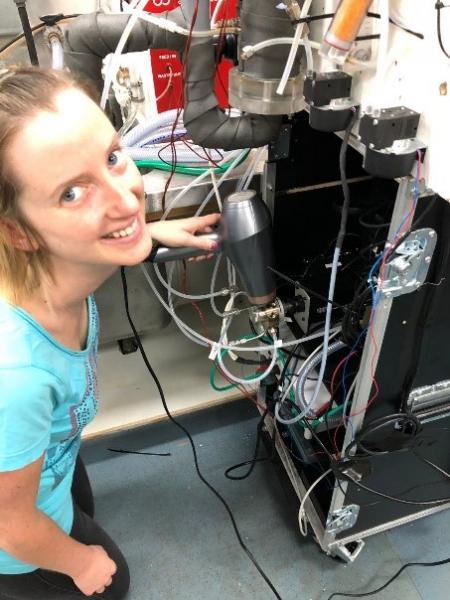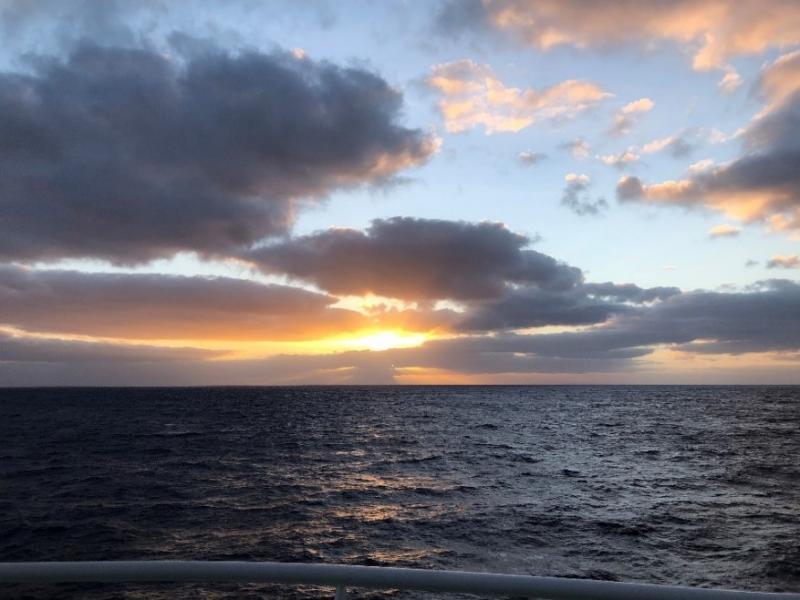By Hannelore Theetaert.

While I am writing this, it is 4 o’clock in the morning, and it’s the start of the last two weeks of sailing. CTD number 99 is currently going down to more than 5,500m depth and the night-shift is up and running. In a few hours we will sample the Niskin bottles, 10- or 20-litre bottles that remotely collect seawater on different depths, for oxygen, dissolved inorganic carbon (DIC)/total alkalinity (TA), nutrients and salts (i.e., salinity). This while we probably search for a new ‘word of the day’, sing the ‘whisky and beer’ song sitting on the sampling bench, or can’t stop laughing at the bad jokes from our entertainers Charles and Dan. However my first job of the day is to check on my three ‘sisters’ – that’s how everybody refers to my three systems. I check if they are still working fine, and that they have no issues.

I’m Hannelore, or Hannah, since nearly nobody can pronounce my name, working at the Flanders Marine Institute (VLIZ) in Belgium and measuring underway pCO2 and total alkalinity (TA) on the surface seawater during the whole transect from Florida to Tenerife. Those two parameters are usually not measured frequently during most of the cruises and will be a great compliment to the discrete measurements of DIC and Total alkalinity that are taken between the surface 5m and the maximum water depth along this transect. They will also allow us to examine the full carbonate system at much higher resolution.
To measure pCO2 and TA, I installed three systems connected with the non-toxic underway system of the ship. For pCO2 a VLIZ custom made UW system using the Picarro (G2201-i), coupled to a marble showerhead equilibrator and a Contros HydroC-CO2 FT, are used and for TA the Contros HydroFia-TA system is used.

The three systems have behaved well for most of the transect now, and have produced good data. However after the first week of sailing, due to the bad weather, some water came in to the Picarro. Since the internal cell of the Picarro needs to stay as dry as possible, this was not a very good thing to happen. At first sight things didn’t look to good, but with a lot of love, patience and my hairdryer, things turned out for the best and the system was up and running again after three days.
On the ship I am also part of the oxygen and nutrients team. So when I am not taking care of ‘my sisters’ I am busy sampling oxygen and nutrients and doing the oxygen analysis in the lab during the nightshifts. Working in the lab during the night is a totally new experience especially if you need to have your dinner or ‘brinner’ at 11.30 in the evening.

The dayshift (Maria) figured out we even have our ‘own room’ here on the ship. I am not quite sure how many oxygen samples I have been analyzing by now but anyway ‘Practice makes perfect’.
The experience has been great for the four weeks that have passed now, laughed a lot, improved my English dictionary with ‘the words of the day’: stupendous, inconceivable, bizarre, preposterous…
But something that I definitely will not forget is every sunrise that we watched in the morning!